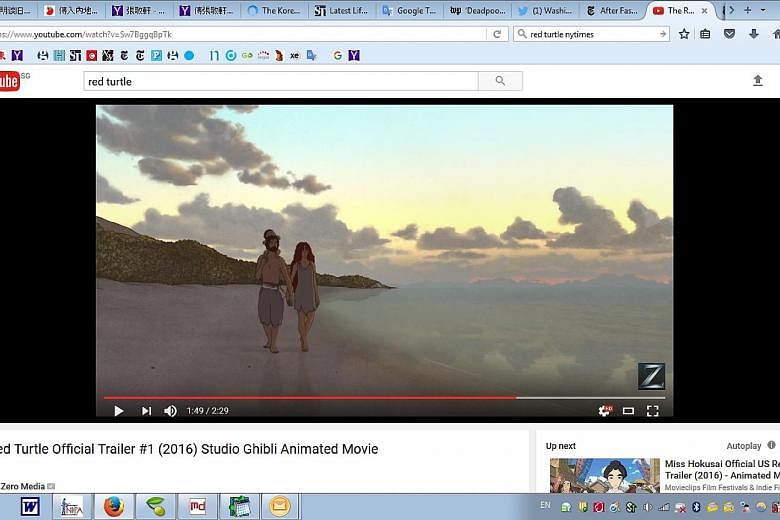NEW YORK • You will not find a moving castle, forest spirits or a pig pilot in the latest film from Studio Ghibli. You will also not find dialogue.
The Red Turtle is a distinct departure for the Japanese studio - the first time its producers have worked with a European director on a feature.
The Red Turtle is a stark man-on- a-desert-island tale that speaks with its visuals rather than its characters. And it is exactly the kind of film Studio Ghibli producers were hoping for when they commissioned Dutch director Michael Dudok de Wit to make it.
He captured the studio's attention with his short films such as the Oscar-winning Father And Daughter (2000). That work embodied "an outlook that views life through death", Studio Ghibli producer Toshio Suzuki said. "That seemed to be an Eastern way of thinking."
Here is a look at how The Red Turtle both departs from, and connects to, the Studio Ghibli tradition.
WHAT STUDIO GHIBLI IS KNOWN FOR
An image from Hayao Miyazaki's 1988 feature, My Neighbour Totoro, reflects many of the qualities that the studio's fans have come to love: inventive creatures, a rich colour palette and a sense of adventure.
In a telephone interview from London where he is based, Dudok de Wit explained why he is such a fan of the studio's films. He said: "They have a deep respect for humanity and for nature and they want their films to convey that. And they have respect for big subjects that aren't just pure entertainment", capturing the imagination of children, but also tackling serious themes that connect with adults.
Characters in Studio Ghibli features have a particular way of moving that is more in tune with Japanese body language and, on the whole, animators use fewer drawings a second than in Western animation. "But that is compensated by higher drawing skills," Dudok de Wit said.
The Studio Ghibli backgrounds often have a painterly, watercolour- style beauty to them. But the producers were not expecting, or demanding, of any kind of Japanese animation style from Dudok de Wit.
"I was impressed that Michael made The Red Turtle without any influence from Japanese animation," Suzuki said.
The film was animated by a team at the French studio Prima Linea.
HOW THE RED TURTLE CHANGES THAT
Another image from The Red Turtle, about a castaway whose life is changed when he encounters the reptile of the title, shows some of the ways Dudok de Wit's work takes Studio Ghibli in a new direction.
His style changes project to project, from the cartoonish peppiness of his 1992 short, Tom Sweep, to the more reverent and reserved Father And Daughter, but key signatures can be found throughout his work. "I tend to emphasise shadows a lot," he said. "So they become graphically very strong and create a special ambience."
He also tends to animate his characters small in relation to their surroundings. This is certainly the case with The Red Turtle, which works on a pretty spare scale, showing its protagonist nearly dwarfed by the nature around him.
Dudok de Wit's "style of expression consists of subtraction rather than addition", the film's artistic producer, Isao Takahata of Studio Ghibli, said. "It is the same method seen in the simple, vigorous line drawings in Japanese Zen painting," he said.
Studio producers were impressed by Dudok de Wit's ability to create the feel of density for, say, a character in a forest, through minimally rendered line drawings.
And a minimalist palette is a distinct difference too. "I like films that are monochromatic," Dudok de Wit said. "It gives a purity and a simplicity to the image."
While he knew the feature would need dynamic landscapes and more colour than his shorts had, he still wanted to keep the number of colours to a minimum.
He asked his background artist to use one or two main colours and create variations on them in a scene. "It's like in real life when there are days when all the colours are grey because the sky is cloudy," Dudok de Wit said. "That's beautiful."
NYTIMES

